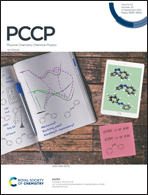Prediction of beryllium clusters (Ben; n = 3–25) from first principles†
Abstract
Evolutionary searches using the USPEX method (Universal Structure Predictor: Evolutionary Xtallography) combined with density functional theory (DFT) calculations were performed to obtain the global minimum structures of beryllium (Ben, n = 3–25) clusters. The thermodynamic stability, optoelectronic and photocatalytic properties as well as the nature of bonding are considered for the most stable clusters. It is found that the cluster with n = 15 is the transition point at which the configurations change from 3D hollow cages to filled cage structures (with an interior atom appearing in the structure). All the ground state structures are energetically favorable with negative binding energies, suggesting good synthetic feasibility for these structures. The calculated relative stabilities and electronic structure show that the Be4, Be10 and, Be17 clusters are the most stable structures and can be considered as superatoms. The electron configurations of Be4, Be10 and Be17 clusters with 8, 20 and 34 electrons are identified as 1S2 1P6, 1S2 1P6 1D10 2S2, 1S2 1P6 1D10 2S2 1F14, respectively. Theoretical simulations determined that all the ground state structures exhibit excellent thermal stability, where the upper-limit temperature that the structures can tolerate is 900 K. During AIMD simulation of O2 adsorption onto the Be17 cluster an interesting phenomenon was happening in which the pristine Be17 cluster becomes a new stable Be17O16 cluster. Based on ELF (electron localization function) analysis, it can be concluded that the Be–Be bonds in the small clusters are primarily of van der Waals type, while for the larger clusters, the bonds are of metallic nature. The Ben clusters show very strong absorption in the UV and visible regions with absorption coefficients larger than 105 cm−1, which suggests a wide range of potential advanced optoelectronics applications. The Be17 cluster has a suitable band alignment in the visible-light excitation region which will produce enhanced photocatalytic activities (making it a promising material for water splitting).



 Please wait while we load your content...
Please wait while we load your content...